Minoxidil & Beard Growth
What’s the story behind Minoxidil?
“Minoxidil, originally used for high blood pressure, works on hair follicles by vasodilating blood vessels, which opens blood flow to the hair roots. Hair follicles then have more access to nutrients, allowing longer, thicker and healthier hair, by extending the growth phase,” says Dr. Lela Lankerani, Westlake Dermatology, Austin.
Minoxidil is an FDA approved, over the counter drug for treating certain types of hair loss. When it is used on the scalp, the hair growth is not permanent and growth is lost after you stop taking Minoxidil. It is important to note: Minoxidil does not create new hair follicles. It can awaken follicles that are dormant but it will not cause your body to create new hair follicles.
While the effects of Minoxidil on the scalp and hair growth are well documented, until recently, there have been few formal medical studies addressing Minoxidil and beard growth.
To understand Minoxidil, it helps to know how hair growth works:
Protein-based cells in your hair follicles start developing into a hair. Follicles are the capsules in your skin that contain your hair. This is the first part of the anagen phase.
Blood vessels around the follicle fuel the protein cells and help the hair grow progressively longer. This is the second part of the anagen phase.
As the hair grows, it comes up and out of the skin, and gets lubricated by an oil gland in your skin. This is the beginning of the catagen phase, when the hair stops growing.
Over time, the hair falls out of the follicle, and the growth cycle begins anew. This is called the telogen phase.
For scalp hair, this cycle takes years. For beard hair and other hair around your body, such as your eyebrows, this cycle only lasts a couple months at most.
Minoxidil’s main function is vasodilation. This means it expands blood vessels and makes the follicles bigger to feed the growth of the hair during the anagen phase. The hair then falls out at a much slower pace, making hair growth on your face look more thick and filled out. Because the blood vessels in your face are larger than those in your scalp, people claim it works even better and faster.
In terms of longevity of the effects, we know that when treatment is stopped for baldness, the gains are lost. To date, there is no scientific research showing that minoxidil beards will last indefinitely after treatment is stopped.
The reality is that beards take time. Most men don’t reach their full beard potential until their mid-30s. Minoxidil is an appealing option for guys looking to grow a fuller beard. Before starting a minoxidil regimen, it is important to consult a medical professional. There can be side effects and there are still many unknowns about how Minoxidil works in regards to beard growth.
Side Effects May Include: Beard
Most people experience no unwanted side effects. Everyone is different, however, and some can find Minoxidil leads to:
redness or irritation of your facial skin scalp irritation
hair growing in areas that you didn’t expect, such as further down your neck or back
new hair colors or textures
abnormal weight loss with no other obvious cause
feeling dizzy or lightheaded
swollen feet or hands
pain in your chest
Alternatives…
There has been encouraging research that seems to indicate a 3% peppermint oil solution might actually be more effective than Minoxidil, you can view this study here.

